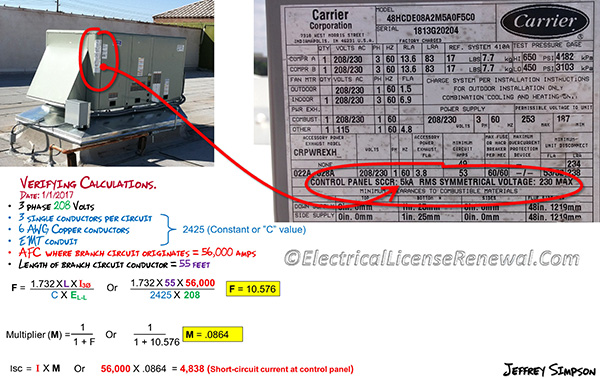440.10 Short-Circuit Current Rating.

Code Change Summary: A new code section was added to address available short-circuit current.
“Available short-circuit current” is the amount of fault current that can be delivered to the equipment during a short circuit condition originating at the equipment. A movement is occurring throughout the NEC® to raise awareness of available fault current, short circuit current ratings (SCCR) and proper application of NEC® 110.9 and 110.10 which have existed rather silently in the NEC® for quite some time.
Most multimotor and combination-load equipment is already required by Section 440.4(B) to be marked with a SCCR. The intent is so that the electrician and inspector can ensure compliance with NEC® 110.9 and 110.10. These sections require a close look at things like overcurrent device ampere interrupt capacity (AIC), circuit impedance, circuit characteristics and SCCR’s of equipment. This is to ensure that the overcurrent device protecting the HVAC equipment is rated properly so that it can eliminate the fault condition before the equipment blows up.
The only way to ensure the HVAC equipment is rated to handle the amount of short circuit current available is to first find out the maximum amount of fault current that could be delivered to the equipment during a short circuit condition and then to determine the SCCR of the equipment by looking at the nameplate. As long as the HVAC equipment has a SCCR equal to or greater than the available short circuit current, then the installation complies with NEC® 110.10.
In the 2017 NEC®, new language requires motor controllers of multimotor and combination-load equipment to be installed in a location where the available short-circuit current does not exceed the SCCR of the equipment. As well, new subsection B states: “When motor controllers or industrial control panels of multimotor and combination load equipment are required to be marked with a short circuit current rating, the available short circuit current and the date the short circuit current calculation was performed shall be documented and made available to those authorized to inspect the installation”.
Knowing the amount of available short circuit current at the HVAC equipment is the first step in ensuring that the HVAC equipment is properly rated for the worst-case fault condition that it may see.
Below is a preview of the NEC®. See the actual NEC® text at NFPA.ORG for the complete code section. Once there, click on their link to free access to the 2017 NEC® edition of NFPA 70.
2017 Code Language:
N 440.10 Short-Circuit Current Rating.
(A) Installation. Motor controllers of multimotor and combination-load equipment shall not be installed where the available short-circuit current exceeds its short-circuit current rating as marked in accordance with 440.4(B).
(B) Documentation. When motor controllers or industrial control panels of multimotor and combination load equipment are required to be marked with a short circuit current rating, the available short circuit current and the date the short circuit current calculation was performed shall be documented and made available to those authorized to inspect the installation.